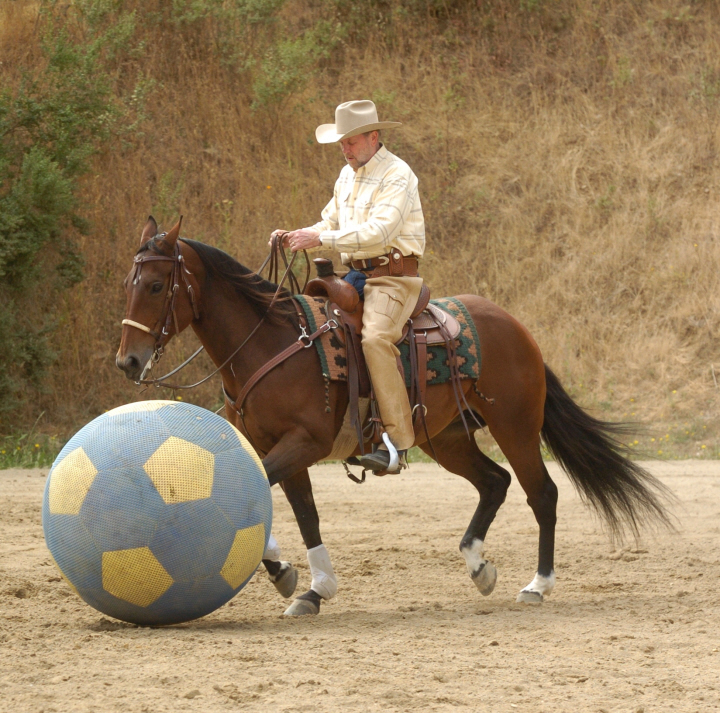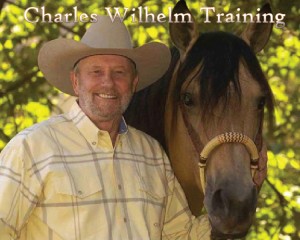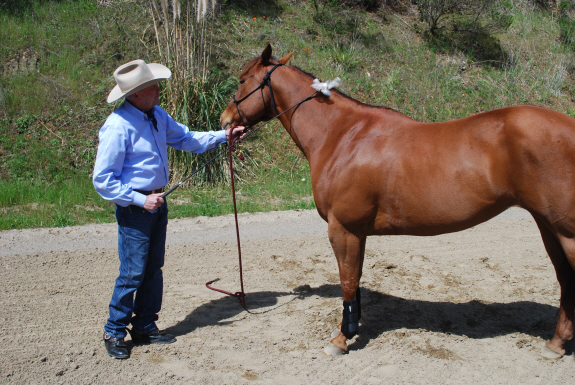The Need for De-Spooking
-By Charles Wilhelm-
An interesting fact about horses is that while they can seem so smart and appear to
learn so fast when we are consistent with them, the flight instinct can take over
quickly. The frightened horse doesn’t care what is in front of him. He is going to run.
A startled or frightened horse will go through barbed wire or over a cliff, and with
you in the saddle. That is why it is so important to spend time and use imaginative
ways of producing a horse that will not react to every little thing that comes along.
De-spooking or sacking out, allows you to bring your horse’s emotional level up then
down. This teaches the horse to change its reaction when startled. We can change
the flight instinct (or bolting reaction) to spooking in place, which is much less
dangerous.
I think of a horse’s emotions on a scale from one to ten, with ten being the highest
and one being very calm. A safe horse that is pleasant to ride is around the level of
two to four. You may have heard the expression, “dead-broke horse,” meaning you
can do anything with the horse and anyone can ride it. I am here to tell you that I
have never found a dead-broke horse! I have seen so called dead-broke horses bolt
and run when they are frightened. There is always something out there that will
scare a horse. This makes de-spooking a very important part of training.
 I once took part in a colt-starting competition with four other trainers. Each of us
I once took part in a colt-starting competition with four other trainers. Each of us
had a different style of training. I did what I do at home when I get a new horse to
work with, round pen training. At the competition, I had the horse go forward in the
round pen, stop, and then face me. When the horse did this and I felt I could
approach him, I put a halter on him. I taught the horse to give to pressure on a lead
line in both the right and left directions. I got him to follow his nose by putting a
rope around his hindquarters and had him follow the direction of the pull. Then, I
taught the horse to drag a tarp. I started putting ropes around his legs and around
his belly, like a cinch, to prepare him for the saddle.
I also introduced the horse to a big soccer ball and a leaf blower to represent
something noisy like a lawn mower, chainsaw or weed whacker. This allowed me to
bring his emotional level up and then down. Most people work on bringing the
emotions down, then when they find themselves in a situation that raises the
emotional level, things can get a lot more explosive. If we bring the emotional level
up in a controlled environment, not out on a trail that is two feet wide and on the
side of a hill, we can have a much safer experience. By introducing scary objects in
an arena, we are not waiting for something to happen to cause the horse to react but
are introducing the horse to a new, scary situation on our own terms.
I did not use the soccer ball and leaf blower exercise for showmanship; these are all
the same tools/exercises I do at home at the ranch. The producer of the competition
was upset and thought these were gimmicks and that this was not horsemanship.
Horsemanship to me is a consideration of the needs of the horse, having respect for
the horse and working with him until he is comfortable and safe. It is also respecting
the needs of the rider, the individual who is going to be riding that horse.
Since most of my clients today are in their mid-thirties or older and are either
returning to the sport or new to it, they want to ride a horse that they know is safe. They don’t want to risk getting hurt. A clinician can sack out a horse with a lariat, get him comfortable with a rope around his belly, throw a saddle on and, in less than an hour, be on the horse’s back. But that is only stealing a ride, which means we can get on the horse. It doesn’t mean the horse is fully trained or that he won’t suddenly bolt. We are sometimes willing to take that risk but my clients are not.
When doing a de-spooking exercise like dragging a tarp, remember to start small
and build the experience in increments. Your horse will tell you where he is in his
training. When you work with your horse and he is still excited and wild-eyed, you
are moving too fast. You need to back up and start again. Go a little slower; take a
little more time. By the end of the exercise, the horse should display a quiet and
relaxed demeanor.
 national clinics and demonstrations.
national clinics and demonstrations. 





















































